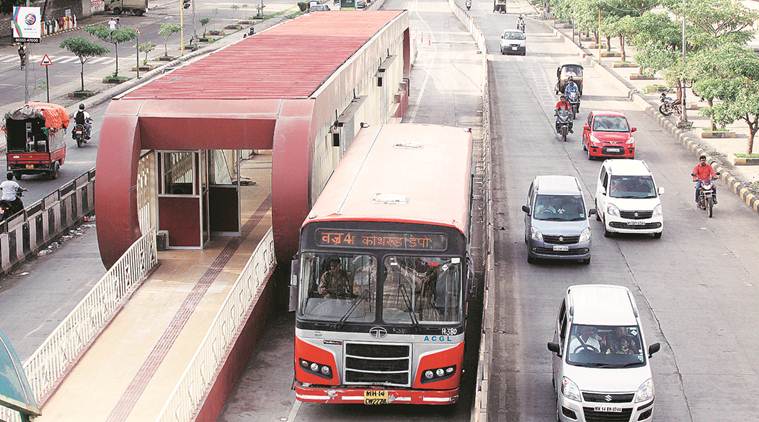THIRTEEN years after the Bus Rapid Transit System (BRTS) was started in December 2006, it has come to a standstill as the city police have opened up the corridors, built exclusively for buses, for all vehicular traffic.
When the project started, it was touted as the first BRTS in the country. However, both Pune Municipal Corporation (PMC) and Pune Mahanagar Parivahan Mahamandal Ltd (PMPML) have drawn flak for not being able to run it smoothly.

Some of the reasons for the BRTS project not working out are beyond PMC and PMPML, like the ongoing Metro work near BRTS stretches. But, pointed out activists, neither adequate staff nor infrastructure had been put in place by the civic body and the transport body to ensure smooth plying of buses on BRTS stretches.
Police have argued that the increasing volume of traffic in the city was finding it difficult to negotiate the narrower stretch of the roads due to the presence of BRTS. “Till Metro work is going on, BRTS will not be operational. This is being done for the safety of commuters and to avoid traffic congestion,” Police Commissioner K Venkatesham told The Indian Express on Saturday.
PMPML Joint Managing Director Ajay Charthankar said, “As per my information, 40-45 per cent of the BRTS stretch is operational. It is not functional in some parts because of ongoing Metro work”.
“BRTS has been a complete failure in Pune city. While the PMC has failed to provide the right infrastructure, PMPML has failed to provide quality buses, frequent service and well-trained staff,” said Prashant Inamdar, convenor of Pedestrians First.
He said nearly Rs 1,500 crore has been spent on BRTS, yet the project continued to falter in Pune city.
The first BRTS
Story continues below this ad
The first BRTS in Pune city was started in the Katraj-Swargate stretch as a pilot project. It ran for a few years but was stopped for renovation a couple of years ago.
In 2017, the PMC started renovation work on the BRTS and since then, the civic body, which is spending approximately Rs 100 crore on the project, has missed at least four deadlines to reopen the BRTS. The PMC has said that it had to undertake renovation to put in place a new design.
Swargate-Hadapsar
It was called a ‘half-BRTS’ and was completed partially. When the construction of a flyover started in Swargate area, the BRTS was dismantled. “On the 7-km stretch, there was no BRTS for 3.2 km because that area fell under the Pune Cantonment Board. This was never a BRTS at all,” said activist Qaneez Sukhrani.
Aniruddha Pawaskar, who heads the PMC’s road department, said the civic body will soon take a call on this BRTS stretch. “We have to take cognisance of Metro work,” he said. PMC officials said the BRTS stretch was operational in parts.
Yerawada-Wagholi
Story continues below this ad
This stretch has seen more accidents than the others. Vehicles straying into the BRTS route has been a common sight. In the peak hours in mornings and evenings, the stretch used to turn into a nightmare for vehicular traffic. While it was thrown open to vehicular traffic three months ago, there was some confusion among commuters. A month ago, a board was put up at the site, making it clear that all vehicles could ply on the stretch.
“The Metro project had blocked some portion of the BRTS stretch. Vehicular traffic, including PMPML buses, had moved into the main part of the road. Therefore, we had suggesting opening it up and they took a sensible decision,” said Sukhrani.
Sangamwadi-Vishrantwadi
Like the Yerawada-Wagholi BRTS stretch, the Sangamwadi-Vishrantwadi route has also proved to be a nightmare for traffic, and this has finally prompted traffic police to throw it open to all vehicles. Police said the volume of traffic on both Yerawada-Wagholi and Sangamwadi-Vishrantwadi routes was too heavy and therefore they had no choice but to throw the stretch open for all vehicles.
On the 4.5 km-long Sangamwadi-Vishrantwadi stretch, there is no bus shelter for the first 3 km, only a railing. “After the railing, two half bus shelters can be seen… nobody knows where the bus lane starts, where the service lanes and motor vehicle lanes are,” said Sukhrani.
Story continues below this ad
Don’t miss from Explained: How vehicles are tested for pollution
Pimpri-Chinchwad
In neighbouring Pimpri-Chinchwad, three BRTS routes have been operating smoothly for the last two to three years. The Pimpri-Chinchwad Municipal Corporation is also planning to launch its fourth BRTS. The opening of BRTS route on the Nigdi-Dapodi stretch has come as a relief to commuters as it has considerably reduced their commuting time.

 ‘40-45 per cent of BRTS is operational,’ said officials
‘40-45 per cent of BRTS is operational,’ said officials




































